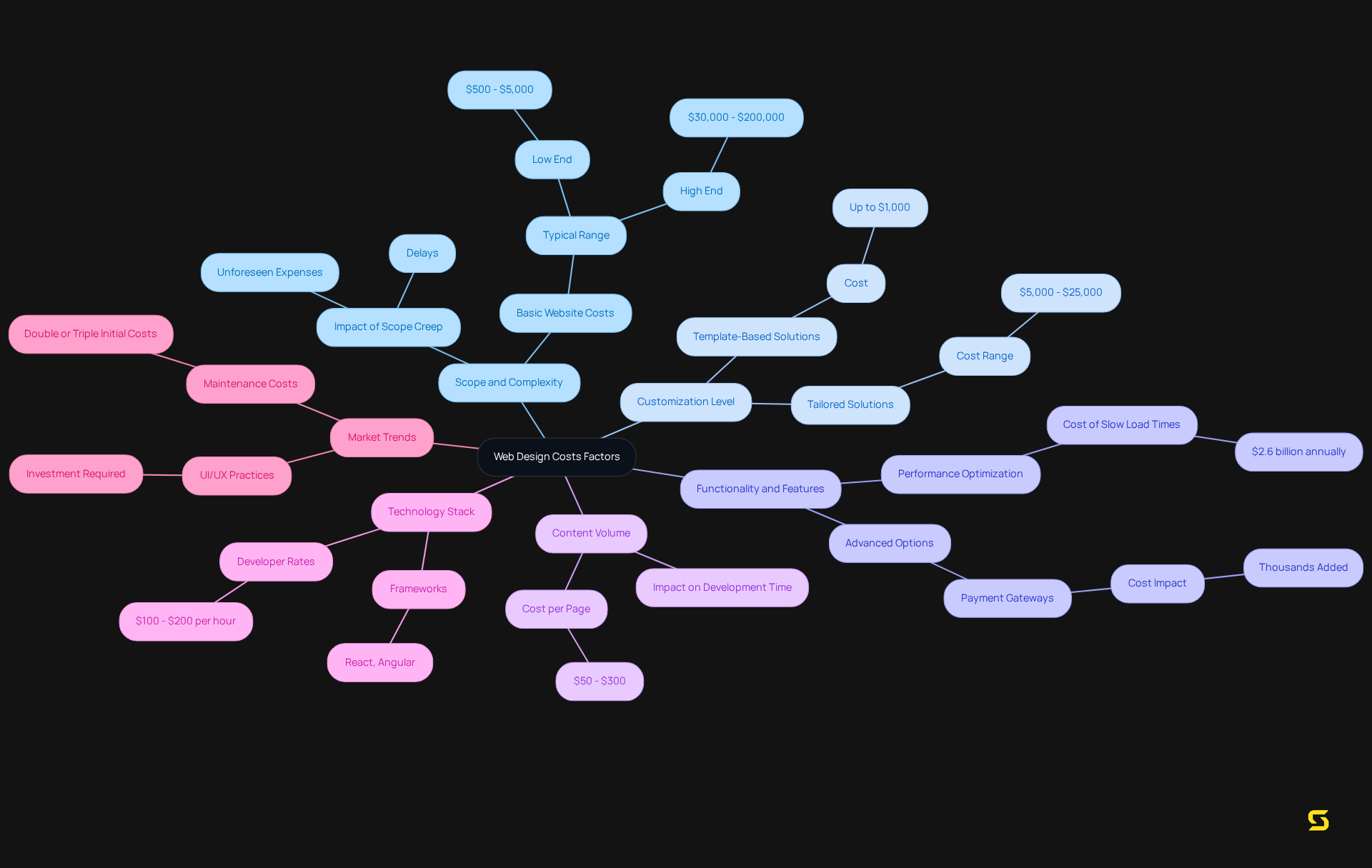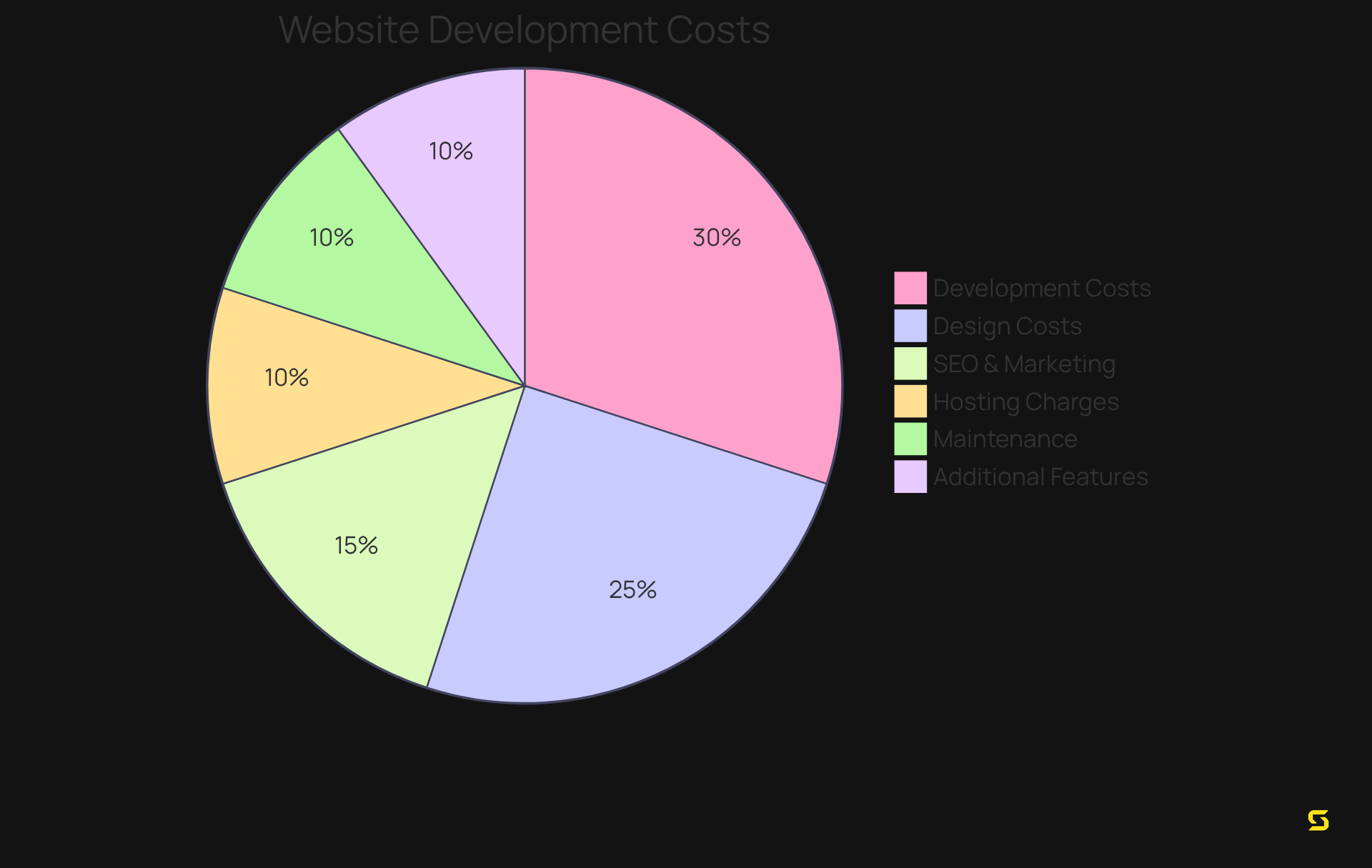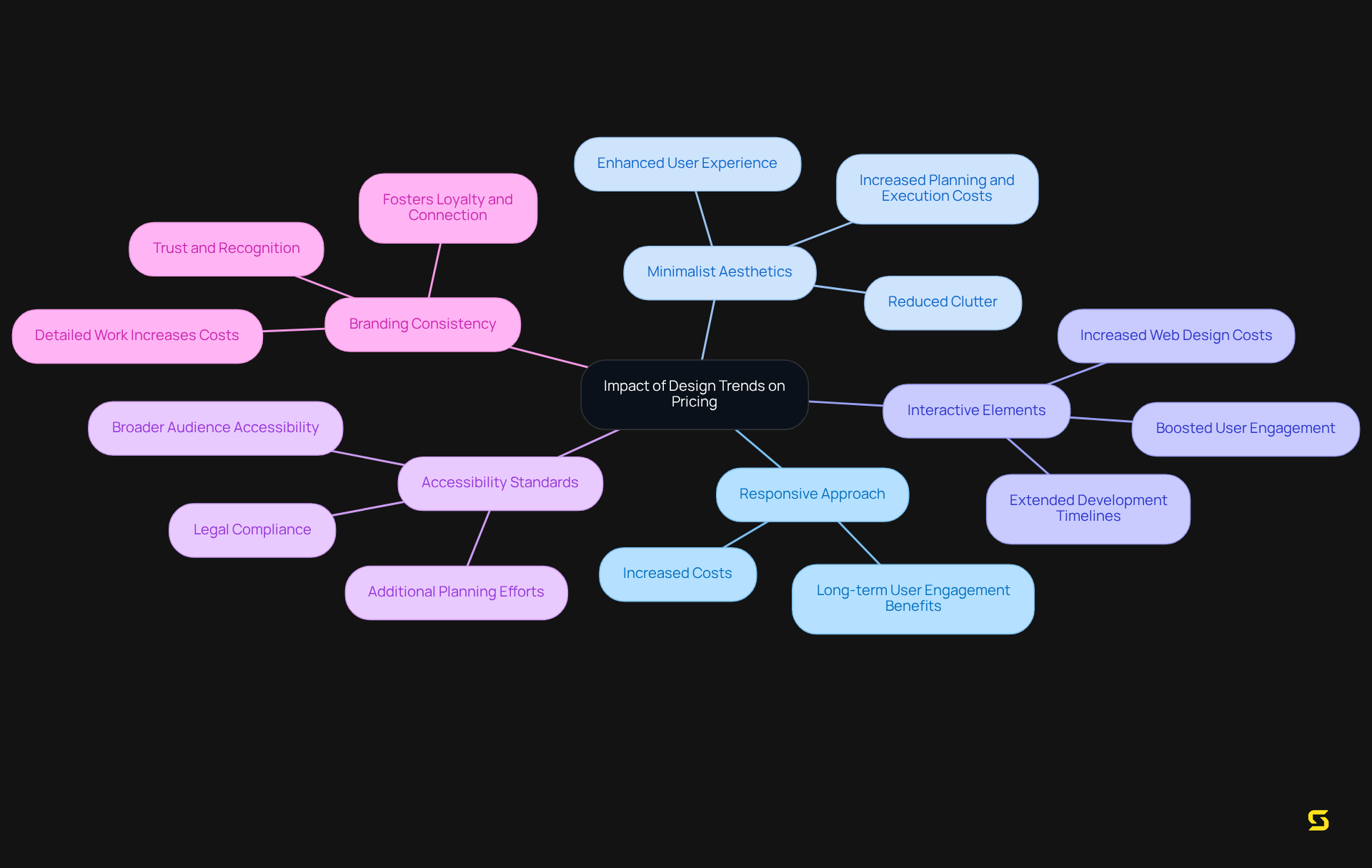Overview
This article delves into the critical factors that determine web design costs, offering a thorough breakdown of the pricing components involved. It asserts that costs are predominantly influenced by:
- The project's scope and complexity
- The degree of customization required
- The desired functionalities
Supported by relevant examples and data, it illustrates how these elements can profoundly impact budgeting decisions, ultimately guiding readers to make informed financial choices in their web design projects.
Introduction
Understanding the financial landscape of web design is essential for businesses seeking to establish a robust online presence. The costs associated with creating a website can vary dramatically, influenced by several key factors such as:
- Project scope
- Customization
- Desired functionalities
As organizations navigate this complex terrain, they face the challenge of balancing budget constraints with the necessity for high-quality design. To effectively allocate resources and achieve optimal results, businesses must grasp the essential elements that influence web design pricing.
Explore Key Factors Influencing Web Design Costs
- Scope and Complexity: The scale and intricacy of an endeavor are paramount in establishing expenses. A basic website with a few pages typically incurs a lower web design cost compared to a complex e-commerce platform that integrates multiple functionalities. A clearly outlined scope is essential; it helps avoid scope creep, which can lead to unforeseen expenses and delays. Case studies consistently demonstrate that initiatives with well-defined requirements tend to stay within budget, facilitating improved resource allocation. Maksym Babych notes that the web design cost for developing a website can reach $30,000 or exceed $200,000, underscoring the importance of understanding project scope in budgeting.
- Customization Level: Tailored solutions designed to meet specific business needs necessitate additional time and expertise, resulting in increased expenses compared to template-based options. The costs associated with hiring a UX/UI designer, which contribute to the web design cost, can range from $5,000 to $25,000, highlighting the investment required for quality design. Businesses must carefully consider the advantages of unique branding against the additional investment needed for custom solutions.
- Functionality and Features: Functionality and features, such as advanced options like user accounts, payment gateways, and custom integrations, considerably elevate the web design cost due to the extra development work involved. For instance, incorporating a payment gateway can add thousands to the project budget, contingent on the complexity of the integration. Moreover, slow-loading websites can cost retailers $2.6 billion annually in lost conversions, emphasizing the critical need to invest in performance optimization.
- Content Volume: The volume of material—including text, images, and videos—significantly impacts the development process and, consequently, the expenses incurred. A larger quantity of content typically necessitates additional design and development time, thereby increasing the web design cost. Businesses should anticipate expenses related to content creation, which can vary from $50 to $300 per page.
- Technology Stack: The , such as frameworks like React or Angular, can influence costs based on the complexity and expertise required for implementation. Specialized developers may command higher rates, reflecting their skill level and the intricacies of the chosen technology. Full-stack developers generally charge between $100 and $200 per hour, which can substantially affect the web design cost and the overall project budget.
- Market Trends: Staying informed about current style trends can impact pricing. For example, integrating modern UI/UX practices often requires additional investment in design resources. As customer expectations evolve, companies must adapt their online platforms accordingly, which can lead to higher web design costs but ultimately enhances user interaction and satisfaction. Additionally, it is crucial to consider that maintenance expenses for online platforms can double or triple the initial development costs, making it essential to plan for ongoing expenditures.

Break Down the Components of Web Design Pricing
- Design Costs: This encompasses the charges for developing the visual elements of the site, including layout, color schemes, and typography. Basic layouts may start around $500, while personalized creations can vary from $3,000 to $50,000. As Sarah Berry notes, the web design cost for developing and designing a website averages between $1,000 and $145,000, highlighting the variability based on customization and complexity.
- Development Costs: This covers the coding and technical implementation of the design. Depending on the complexity, the web design cost can fluctuate significantly, often falling between $1,000 and $100,000. For instance, creating a platform akin to Airbnb can require an investment of between $100,000 and $150,000, illustrating the potential funding needed for more complex sites.
- Hosting and Domain Charges: Continuous expenses for hosting the site and managing the domain name are crucial for online presence. Hosting may vary from $3 to $150 per month, whereas domain registration generally requires about $10 to $20 each year. With as of 2023, these expenses are essential for sustaining a digital identity.
- Maintenance and Updates: Regular updates and maintenance are essential for site performance and security. This can range from $20 to $100 monthly, depending on the level of service needed. Comprehensive packages may offer additional support and features, ensuring the website remains functional and secure.
- SEO and Marketing: If included, these services can significantly impact the overall budget. Basic SEO services may start at $500, while comprehensive marketing strategies can increase expenses significantly, reflecting the importance of visibility in a competitive online environment. Investing in SEO is essential, as 80% of shoppers begin their product research online.
- Additional Features: Attributes such as e-commerce functionalities, custom plugins, and third-party integrations can incur significant expenses, often varying from $1,000 to $20,000 based on the requirements. The complexity of these features directly influences the overall web design cost, making it essential for businesses to carefully assess their needs.

Understand the Impact of Design Trends on Pricing
- Responsive Approach: As mobile device usage continues to rise, implementing responsive strategies has become essential. While introducing this feature can lead to increased costs, specifically in web design cost due to the necessity for extensive testing and adjustments across various screen sizes, the long-term benefits in user engagement and satisfaction are undeniable.
- Minimalist Aesthetics: Embracing minimalist aesthetics can significantly reduce clutter and elevate the user experience. However, this approach demands meticulous planning and execution, which may lead to an increase in web design cost. The investment pays off by creating a streamlined interface that resonates with users.
- Interactive Elements: The integration of animations and interactive features can substantially boost user engagement. Nevertheless, it is important to recognize that these enhancements also contribute to extended development timelines and increased web design cost. The payoff, however, is a more vibrant and engaging user experience.
- Accessibility Standards: Ensuring compliance with accessibility standards is not merely a legal obligation but a commitment to inclusivity. This endeavor requires additional planning and development efforts, which can affect the overall web design cost. Yet, the result is a website that is accessible to a broader audience, enhancing brand reputation.
- Branding Consistency: Upholding a consistent brand identity across all design elements is crucial for building trust and recognition. This commitment often necessitates more detailed work, which can influence the web design cost. However, the value of a cohesive brand image cannot be overstated, as it fosters loyalty and customer connection.

Conclusion
Understanding the costs associated with web design is crucial for businesses aiming to establish a robust online presence. This article delves into the various factors influencing web design expenses, emphasizing the importance of:
- Project scope
- Customization
- Functionality
- Content volume
- Technology stack
- Market trends
By grasping these elements, businesses can make informed decisions about their web design investments, ensuring effective resource allocation and avoidance of unexpected financial burdens.
Key insights reveal that complexity and customization significantly drive up costs, while advanced functionalities and a large volume of content can further inflate budgets. The choice of technology and adherence to current design trends also play pivotal roles in determining overall expenses. Additionally, ongoing costs such as maintenance, hosting, and SEO must be factored into the long-term budget, highlighting the necessity for comprehensive financial planning.
Ultimately, investing in quality web design is not merely a cost but a strategic decision that can yield substantial returns. As digital landscapes evolve, businesses must prioritize their online platforms to meet user expectations and enhance engagement. By understanding the intricacies of web design costs, organizations can better navigate the complexities of the digital market, ensuring their investment translates into a powerful online presence that drives growth and success.
Frequently Asked Questions
What are the main factors influencing web design costs?
The main factors include scope and complexity, customization level, functionality and features, content volume, technology stack, and market trends.
How does the scope and complexity of a project affect web design costs?
A basic website with a few pages incurs lower costs compared to a complex e-commerce platform. Clearly outlining the project scope helps prevent scope creep, which can lead to unexpected expenses and delays.
What is the cost range for developing a website?
Web design costs can range from $30,000 to over $200,000, depending on the project's scope and complexity.
How does customization impact web design costs?
Customized solutions tailored to specific business needs require more time and expertise, leading to higher costs compared to template-based options. Hiring a UX/UI designer can cost between $5,000 and $25,000.
What role do functionality and features play in web design costs?
Advanced functionalities like user accounts and payment gateways significantly increase costs due to additional development work. For example, adding a payment gateway can add thousands to the project budget.
How does content volume affect web design costs?
A larger volume of content, including text, images, and videos, requires more design and development time, increasing costs. Content creation expenses can range from $50 to $300 per page.
How does the technology stack influence web design costs?
The choice of technology, such as frameworks like React or Angular, affects costs based on the complexity and expertise required. Specialized developers may charge higher rates, impacting the overall budget.
What impact do market trends have on web design costs?
Staying current with design trends may require additional investment in resources. Adapting to evolving customer expectations can lead to higher costs but improves user interaction and satisfaction.
What should businesses consider regarding ongoing expenses for web design?
Maintenance costs for online platforms can double or triple initial development costs, making it crucial for businesses to plan for ongoing expenditures.





